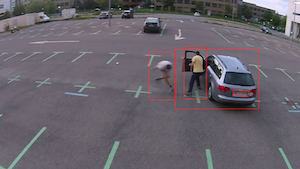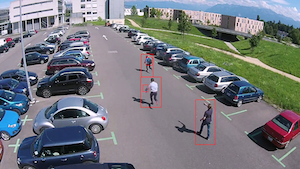Introduction
Drone-based surveillance is particularly advantageous when it is not possible to set up a full-fledged surveillance system, for example, when a temporary major event such as a concert or a marathon is organized. Mini-drones can be used for monitoring the area, helping in managing parking spaces, controlling crowds and reporting useful information such as suspicious behaviors, mis-parked cars, number of free parking spots, etc.
Dataset in details
The created dataset consists of 38 different contents captured in full HD resolution, with a duration of 16 to 24 seconds each, shot with the mini-drone Phantom 2 Vision+ in a parking lot. The dataset contents can be clustered in three categories: normal, suspicious, and illicit behaviors. Normal content depicts people walking, getting in their cars and parking their vehicles. In suspicious content, nothing a priori wrong happens but people act in a questionable way. Contents with illicit behaviors show people mis-parking their vehicles, stealing items and cars, or fighting. All participants read and signed a consent form, stating they agree to appear with their vehicles in the video.


Annotations
The following several privacy-sensitive regions of interest were manually annotated using the open source ViPER-GT tool:
- Body silhouette: Rectangle around the body region with recorded information about gender, ethnicity and age. Stored information about the surveillance scenario: the main action, such as stealing or parking, and the role, such as thief or driver;
- Facial region: Rectangle around the face;
- Accessories. Rectangle around each personal item such as bag, backpack, sunglasses, hat, wallet or bottle;
- Vehicle: Rotated rectangle around the vehicle body, car or bicycle.
- License plate: Rotated rectangle around the license plate. Number of license plate recorded;
- Video capture: Information about video format, including resolution, frame rate, and the total number of frames.
Since the dataset was created to evaluate different aspects and definitions of privacy, the attribute ‘level of privacy content’ is reported for each ROI and defined as low (L), medium (M), or high (H). It is related to the distance between the region and the drone and to the amount of visible details. The ROIs face and license plate are more sensitive than the others. A person can be recognized more easily if his face is visible and the number of the license plate can help to identify the owner of the vehicle. Therefore, their default value for ‘level of privacy content’ attribute is H while for other regions of interest it is set to L.
All annotations are provided in a flexible XML format together with video files.
Download
You can use Mini-drone dataset in your research without any conditions, as long as you clearly mention and acknowledge the following paper:
M. Bonetto, P. Korshunov, G. Ramponi, and T. Ebrahimi. Privacy in Mini-drone Based Video Surveillance. Workshop on De-identification for privacy protection in multimedia, Ljubljana, Slovenia, 2015.
You can download all video files and associated XML-based annotations from the following FTP (please use dedicated FTP clients, such as FileZilla or FireFTP):
Protocol: FTP
FTP address: tremplin.epfl.ch
Username: datasets@mmspgdata.epfl.ch
Password: ohsh9jah4T
FTP port: 21
After you connect, choose the minidrone folder from the remote site, and download the relevant material.
Please check the ‘VideoDataset_Description.xls’ file inside the download folder for the description of video sequences. You may also check the above paper for some other helpful information.
In case of any problems or questions, please send an email to pavel.korshunov (at) epfl.ch
Copyright
Permission is hereby granted, without written agreement and without license or royalty fees, to use, copy, modify, and distribute the data provided and its documentation for research purpose only. The data provided may not be commercially distributed. In no event shall the Ecole Polytechnique Fédérale de Lausanne (EPFL) be liable to any party for direct, indirect, special, incidental, or consequential damages arising out of the use of the data and its documentation. The Ecole Polytechnique Fédérale de Lausanne (EPFL) specifically disclaims any warranties. The data provided hereunder is on an “as is” basis and the Ecole Polytechnique Fédérale de Lausanne (EPFL) has no obligation to provide maintenance, support, updates, enhancements, or modifications.